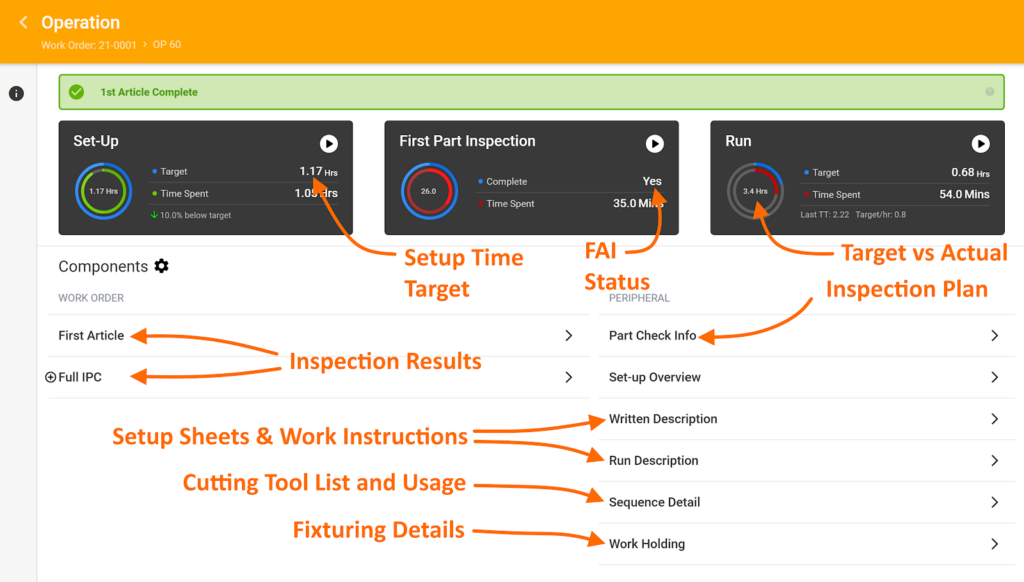Process
& Scheduling
Management
Maintenance
Management
& Inspection
& Material Planning
Financial Data
Management
Written by: Paul Van Metre and David Vuyk
I’d bet that most shop owners would love to increase their shop-floor productivity. That’s a pretty easy idea to get behind as a business leader. Like many things though, it’s easier said than done. Finding a way to increase output and efficiency while decreasing waste in a manufacturing operation is no trivial matter. Honing in on a solution is anything but simple, which is what leads so many shop owners to settle for a system that is “good enough for now”. The problem is, playing that average game will provide you with an average result, or perhaps worse.
Previous blogs have focused on what you can do to implement a rock solid job planning process as well as how ProShop aids in the documentation of work instructions. Having these two fundamental systems along with a means of managing active work orders creates the basis for an effective manufacturing execution system (MES). It’s the way that these systems work in harmony that allows manufacturers to make meaningful improvements to their on-time delivery, employee productivity, profitability, and scrap rate.
It’s easy to feel complacent with a system that seems “good enough,” but how is that limiting the potential of your business? When we install better systems, we get better results and provide a better experience to our customers, our vendors, and our employees.
At the core of this dilemma is the need for integration between all the moving parts of a job. Every successfully completed job is the result of “getting it right” with planning, scheduling, purchasing, programming, production, QC, shipping, and accounting to name a few of the steps. Having a system for each of those steps is great, but if those individual systems don’t integrate from one to the next, there will be wasted time, miscommunication, increased effort, and increased risk. This is where your “good enough” system with paper records, whiteboards, and excel sheets may start to show some weaknesses. Finding the right information for a job might be like finding the right tool from the workbench below. You’re pretty sure the information is there somewhere, you just can’t find it when you need it, and sometimes you grab the wrong one.

Like many of the challenges that shop owners face, this one doesn’t just appear out of thin air. Operating without a robust and connected system for manufacturing execution is certainly possible, especially when the business is small. That said, as the size, quantity, and complexity of jobs increase, so do the risks of missing key details or getting things wrong. If operating from written notes, memory, and intuition isn’t working for you anymore, then it might be time to consider doing things differently.
What to look for:
Once you’ve finally had enough and are looking to make a change, there’s several factors that you need to keep in mind when evaluating new systems:
Successful job execution shouldn’t be a mystery:
ProShop’s digital work order system allows you to define the manufacturing process and provide production staff with a step-by-step process to complete active jobs correctly and on-time. Part of the magic involves the tie-in of different departments so that teams are aligned on when and where they need to be involved so that no time is wasted. This includes integrated tools for:
The resulting visibility on your operations allows for a higher volume of active jobs to be concurrently processed while meeting quality and delivery targets. When the process is defined and progress is measured, there’s no confusion about what jobs need to be worked on and who needs to be working on them. Change can be good!
Get clarity about your operations:
There’s no need to reinvent the wheel by trying to piece a solution together yourself. ProShop ERP was designed on the shop floor in response to the same challenges that you’re experiencing right now.
ProShop’s digital work order system allows you to eliminate those old paper travelers and get connected to the entire process. Digital work orders provide a complete picture of all manufacturing information that is available with just a few clicks, along with visibility into:

What could that level of visibility do for your shop? Clients tell us time and time again that they see about a 25% increase in overall shop throughput, when compared to their old systems. That’s meaningful!
Set-up staff and operators will enjoy easy-to-access visual work instructions to guide them. Whenever steps are marked off as completed, digital sign offs will tell you exactly what date and time a user has signed off on that step. Work Orders also have a configurable built-in check list system which can dramatically reduce errors, and speed up set-up times.
Looking to get unstuck from your current system? We’d love to demonstrate how ProShop can help you decrease frustration and increase your business performance. Get in touch with our team today and start achieving more with less!


